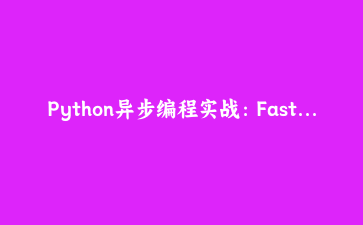掌握现代Python并发编程核心技术,构建高性能应用系统
发布日期:2024年1月
难度等级:中级→高级
一、异步编程核心概念解析
为什么需要异步编程?
在传统的同步编程模型中,I/O操作会阻塞整个程序的执行,导致资源浪费和性能瓶颈。异步编程通过非阻塞I/O和事件循环机制,实现了高效的并发处理。
核心概念对比
| 编程模式 | 执行方式 | 资源占用 | 适用场景 |
|---|---|---|---|
| 同步编程 | 顺序执行,阻塞等待 | 高(线程/进程) | CPU密集型任务 |
| 多线程编程 | 并行执行,GIL限制 | 中等 | I/O与CPU混合 |
| 异步编程 | 协程切换,非阻塞 | 低 | I/O密集型任务 |
Python异步演进历程
# Python异步编程发展历程
Python 3.4 → 引入asyncio模块,@asyncio.coroutine装饰器
Python 3.5 → 引入async/await语法
Python 3.7 → async/await成为正式关键字
Python 3.8 → 异步推导式,异步生成器
Python 3.9 → 异步上下文管理器改进
Python 3.11 → 异步任务组,性能大幅提升二、Asyncio基础详解与实战
1. 基础异步函数定义
import asyncio
import time
async def say_after(delay, message):
"""基础异步函数示例"""
await asyncio.sleep(delay)
return f"{message} after {delay} seconds"
async def main():
# 顺序执行
start_time = time.time()
result1 = await say_after(1, "Hello")
result2 = await say_after(2, "World")
print(result1)
print(result2)
print(f"顺序执行耗时: {time.time() - start_time:.2f}秒")
# 运行结果:
# Hello after 1 seconds
# World after 2 seconds
# 顺序执行耗时: 3.00秒2. 并发执行与任务管理
async def concurrent_main():
"""并发执行示例"""
start_time = time.time()
# 创建任务并发执行
task1 = asyncio.create_task(say_after(1, "Hello"))
task2 = asyncio.create_task(say_after(2, "World"))
# 等待所有任务完成
results = await asyncio.gather(task1, task2)
for result in results:
print(result)
print(f"并发执行耗时: {time.time() - start_time:.2f}秒")
# 运行结果:
# Hello after 1 seconds
# World after 2 seconds
# 并发执行耗时: 2.00秒3. 异步上下文管理器
import aiofiles
class AsyncDatabaseConnection:
"""异步数据库连接示例"""
def __init__(self, connection_string):
self.connection_string = connection_string
self.connected = False
async def __aenter__(self):
print(f"连接到: {self.connection_string}")
await asyncio.sleep(0.1) # 模拟连接延迟
self.connected = True
return self
async def __aexit__(self, exc_type, exc_val, exc_tb):
if self.connected:
print("关闭数据库连接")
self.connected = False
async def query(self, sql):
if not self.connected:
raise RuntimeError("数据库未连接")
await asyncio.sleep(0.05) # 模拟查询延迟
return f"查询结果: {sql}"
async def use_async_context():
async with AsyncDatabaseConnection("postgresql://localhost/db") as db:
result = await db.query("SELECT * FROM users")
print(result)三、高级异步编程模式
1. 异步迭代器与生成器
class AsyncDataStream:
"""异步数据流迭代器"""
def __init__(self, data_list):
self.data = data_list
self.index = 0
def __aiter__(self):
return self
async def __anext__(self):
if self.index >= len(self.data):
raise StopAsyncIteration
# 模拟异步数据获取
await asyncio.sleep(0.1)
item = self.data[self.index]
self.index += 1
return item
async def process_data_stream():
"""处理异步数据流"""
async for item in AsyncDataStream([1, 2, 3, 4, 5]):
processed = item * 2
print(f"处理数据: {item} → {processed}")
# 异步生成器
async def async_generator(limit):
"""异步生成器示例"""
for i in range(limit):
await asyncio.sleep(0.1)
yield i * 2
async def use_async_generator():
async for value in async_generator(5):
print(f"生成值: {value}")2. 信号量与限流控制
class RateLimiter:
"""异步限流器"""
def __init__(self, rate_limit):
self.semaphore = asyncio.Semaphore(rate_limit)
async def call_api(self, request_id):
async with self.semaphore:
print(f"请求 {request_id} 开始执行")
await asyncio.sleep(1) # 模拟API调用
print(f"请求 {request_id} 完成")
return f"Response_{request_id}"
async def test_rate_limiter():
limiter = RateLimiter(2) # 限制并发数为2
tasks = []
for i in range(6):
task = asyncio.create_task(limiter.call_api(i))
tasks.append(task)
results = await asyncio.gather(*tasks)
print("所有请求完成:", results)3. 异步队列与生产者消费者模式
async def producer(queue, producer_id, item_count):
"""异步生产者"""
for i in range(item_count):
item = f"产品_{producer_id}_{i}"
await queue.put(item)
print(f"生产者 {producer_id} 生产: {item}")
await asyncio.sleep(0.1)
# 发送结束信号
await queue.put(None)
async def consumer(queue, consumer_id):
"""异步消费者"""
while True:
item = await queue.get()
if item is None:
# 将结束信号放回,让其他消费者也能收到
await queue.put(None)
break
print(f"消费者 {consumer_id} 消费: {item}")
await asyncio.sleep(0.2) # 模拟处理时间
queue.task_done()
async def producer_consumer_demo():
"""生产者消费者模式演示"""
queue = asyncio.Queue(maxsize=10)
# 创建生产者和消费者任务
producers = [
asyncio.create_task(producer(queue, i, 3))
for i in range(2)
]
consumers = [
asyncio.create_task(consumer(queue, i))
for i in range(3)
]
# 等待所有生产者完成
await asyncio.gather(*producers)
# 等待队列清空
await queue.join()
# 取消消费者任务
for consumer_task in consumers:
consumer_task.cancel()四、高性能Web应用实战
1. 基于Aiohttp的Web服务器
from aiohttp import web
import json
class AsyncUserService:
"""异步用户服务"""
def __init__(self):
self.users = {}
self.next_id = 1
async def create_user(self, user_data):
user_id = self.next_id
self.users[user_id] = {
'id': user_id,
**user_data,
'created_at': '2024-01-01'
}
self.next_id += 1
await asyncio.sleep(0.01) # 模拟数据库操作
return self.users[user_id]
async def get_user(self, user_id):
await asyncio.sleep(0.005)
return self.users.get(user_id)
async def get_all_users(self):
await asyncio.sleep(0.01)
return list(self.users.values())
# 创建Web应用
user_service = AsyncUserService()
async def create_user_handler(request):
"""创建用户处理器"""
try:
data = await request.json()
user = await user_service.create_user(data)
return web.json_response(user, status=201)
except Exception as e:
return web.json_response(
{'error': str(e)},
status=400
)
async def get_user_handler(request):
"""获取用户处理器"""
user_id = int(request.match_info['user_id'])
user = await user_service.get_user(user_id)
if user:
return web.json_response(user)
else:
return web.json_response(
{'error': 'User not found'},
status=404
)
async def get_users_handler(request):
"""获取所有用户处理器"""
users = await user_service.get_all_users()
return web.json_response(users)
def create_app():
"""创建Web应用实例"""
app = web.Application()
# 注册路由
app.router.add_post('/users', create_user_handler)
app.router.add_get('/users/{user_id:d+}', get_user_handler)
app.router.add_get('/users', get_users_handler)
return app
async def run_web_server():
"""运行Web服务器"""
app = create_app()
runner = web.AppRunner(app)
await runner.setup()
site = web.TCPSite(runner, 'localhost', 8080)
print("Web服务器启动在 http://localhost:8080")
await site.start()
# 保持服务器运行
await asyncio.Future() # 永久运行2. 异步数据库操作
import asyncpg
from datetime import datetime
class AsyncUserRepository:
"""异步用户数据仓库"""
def __init__(self, connection_pool):
self.pool = connection_pool
async def create_table(self):
"""创建用户表"""
async with self.pool.acquire() as conn:
await conn.execute('''
CREATE TABLE IF NOT EXISTS users (
id SERIAL PRIMARY KEY,
name VARCHAR(100) NOT NULL,
email VARCHAR(255) UNIQUE NOT NULL,
created_at TIMESTAMP DEFAULT CURRENT_TIMESTAMP
)
''')
async def create_user(self, name, email):
"""创建用户"""
async with self.pool.acquire() as conn:
return await conn.fetchrow(
'INSERT INTO users (name, email) VALUES ($1, $2) RETURNING *',
name, email
)
async def get_users_paginated(self, page=1, page_size=10):
"""分页获取用户"""
async with self.pool.acquire() as conn:
offset = (page - 1) * page_size
return await conn.fetch(
'SELECT * FROM users ORDER BY id LIMIT $1 OFFSET $2',
page_size, offset
)
async def setup_database():
"""初始化数据库连接池"""
return await asyncpg.create_pool(
'postgresql://user:password@localhost/database',
min_size=5,
max_size=20
)五、性能优化与监控
1. 异步性能分析
import time
import asyncio
from functools import wraps
def async_timing_decorator(func):
"""异步函数执行时间装饰器"""
@wraps(func)
async def wrapper(*args, **kwargs):
start_time = time.perf_counter()
try:
result = await func(*args, **kwargs)
return result
finally:
end_time = time.perf_counter()
print(f"函数 {func.__name__} 执行时间: {end_time - start_time:.4f}秒")
return wrapper
@async_timing_decorator
async def expensive_operation():
"""模拟耗时操作"""
await asyncio.sleep(1)
return "操作完成"
class AsyncProfiler:
"""异步性能分析器"""
def __init__(self):
self.tasks = {}
async def track_task(self, task_name, coroutine):
start_time = time.perf_counter()
result = await coroutine
end_time = time.perf_counter()
self.tasks[task_name] = {
'duration': end_time - start_time,
'completed_at': end_time
}
return result
def print_report(self):
print("n=== 性能分析报告 ===")
for task_name, metrics in self.tasks.items():
print(f"{task_name}: {metrics['duration']:.4f}秒")2. 连接池与资源管理
import aiohttp
from contextlib import asynccontextmanager
class AsyncHttpClient:
"""异步HTTP客户端(带连接池)"""
def __init__(self):
self.session = None
async def __aenter__(self):
timeout = aiohttp.ClientTimeout(total=30)
connector = aiohttp.TCPConnector(limit=100, limit_per_host=20)
self.session = aiohttp.ClientSession(
timeout=timeout,
connector=connector
)
return self
async def __aexit__(self, exc_type, exc_val, exc_tb):
if self.session:
await self.session.close()
async def fetch_multiple_urls(self, urls):
"""并发获取多个URL"""
tasks = []
for url in urls:
task = self.session.get(url)
tasks.append(task)
responses = await asyncio.gather(*tasks, return_exceptions=True)
results = []
for response in responses:
if isinstance(response, Exception):
results.append(f"错误: {response}")
else:
text = await response.text()
results.append(f"状态: {response.status}, 长度: {len(text)}")
await response.release()
return results六、最佳实践与调试技巧
1. 错误处理与重试机制
class AsyncRetryManager:
"""异步重试管理器"""
def __init__(self, max_retries=3, base_delay=1, backoff_factor=2):
self.max_retries = max_retries
self.base_delay = base_delay
self.backoff_factor = backoff_factor
async def execute_with_retry(self, coroutine, *args, **kwargs):
"""带重试的执行"""
last_exception = None
for attempt in range(self.max_retries + 1):
try:
if attempt > 0:
delay = self.base_delay * (self.backoff_factor ** (attempt - 1))
print(f"第 {attempt} 次重试,等待 {delay} 秒")
await asyncio.sleep(delay)
return await coroutine(*args, **kwargs)
except Exception as e:
last_exception = e
print(f"尝试 {attempt + 1} 失败: {e}")
raise last_exception
async def unreliable_operation():
"""模拟不可靠操作"""
import random
if random.random() < 0.7: # 70%失败率
raise RuntimeError("操作失败")
return "操作成功"
async def test_retry():
retry_manager = AsyncRetryManager(max_retries=3)
result = await retry_manager.execute_with_retry(unreliable_operation)
print(f"最终结果: {result}")2. 调试与日志记录
import logging
# 配置异步日志
logging.basicConfig(
level=logging.INFO,
format='%(asctime)s - %(name)s - %(levelname)s - %(message)s'
)
class AsyncTaskManager:
"""异步任务管理器"""
def __init__(self):
self.logger = logging.getLogger('AsyncTaskManager')
self.tasks = set()
async def run_task(self, coroutine, task_name):
"""运行任务并自动管理"""
task = asyncio.create_task(coroutine, name=task_name)
self.tasks.add(task)
# 任务完成时自动清理
task.add_done_callback(self.tasks.discard)
self.logger.info(f"启动任务: {task_name}")
try:
result = await task
self.logger.info(f"任务完成: {task_name}")
return result
except Exception as e:
self.logger.error(f"任务失败 {task_name}: {e}")
raise
async def cancel_all_tasks(self):
"""取消所有任务"""
for task in self.tasks:
task.cancel()
await asyncio.gather(*self.tasks, return_exceptions=True)
self.tasks.clear()
self.logger.info("所有任务已取消")
# 运行完整示例
async def main_demo():
"""主演示函数"""
print("=== Python异步编程实战演示 ===")
# 基础示例
await main()
await concurrent_main()
# 高级模式
await process_data_stream()
await test_rate_limiter()
await producer_consumer_demo()
# 性能测试
profiler = AsyncProfiler()
await profiler.track_task("expensive_operation", expensive_operation())
profiler.print_report()
print("=== 演示完成 ===")
if __name__ == "__main__":
asyncio.run(main_demo())总结与进阶学习
核心技术要点总结:
- 深入理解async/await语法和事件循环机制
- 掌握任务创建、管理和并发执行模式
- 熟练使用异步上下文管理器和迭代器
- 构建高性能的异步Web应用和服务
- 实施有效的性能监控和错误处理策略
进阶学习方向:
- 异步机器学习推理服务
- 实时数据处理管道
- 微服务架构中的异步通信
- 异步测试策略和Mock技术
- 性能调优和内存管理
异步编程是现代Python开发的核心技能,通过本文学到的技术,你将能够构建高性能、可扩展的应用程序系统。















